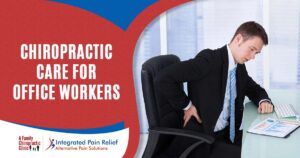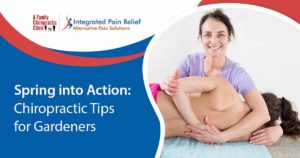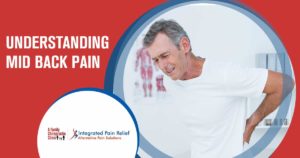Are you experiencing Back Pain?
Back pain is one of the most common ailments among adults. For some, the pain can cause such a disruption to daily life that it actually lowers their quality of life. No matter if you suffer from acute back pain or chronic back pain, there are ways to get pain relief. Chiropractic treatments for lower back pain, middle back pain, and upper back pain. Chiropractors can offer relief for more than just back and neck pain, however.
What Kinds of Conditions Does a Chiropractor Treat?
The spine is the center of the human body. When something is wrong with the spine, it can throw off a delicate balance and cause problems throughout the patient. Medications often treat the symptoms, but not the cause when it comes to neck and back pain.
Many patients that seek chiropractic care come in with low back pain in the lumbar spine, upper back pain in the thoracic spine, or neck pain in the cervical spine. Some people seek chiropractic treatment for back pain after sustaining an injury. However, many people will visit a chiropractor for back pain relief caused by other issues. For example, back pain during pregnancy, back pain during or after exercise, and work conditions can all take their toll on the body. Sometimes, a chiropractic adjustment is just what someone needs to be able to carry on comfortably.
Here are some of the most common causes of pain in the back:
- Muscle Strain: This is a common cause of back pain and typically occurs when the muscles in the back are stretched or torn. It can result from lifting heavy objects, sudden movements, or poor posture. Muscle strains often lead to localized pain, muscle stiffness, and restricted movement.
- Herniated Disc: The spine is made up of vertebrae with intervertebral discs acting as cushions between them. A herniated disc occurs when the soft inner portion of a disc protrudes through the tough outer layer, pressing on nearby nerves. This can cause localized pain in the back, as well as pain, numbness, or weakness in the legs if the affected disc is in the lower back.
- Degenerative Disc Disease: This is a condition that occurs with age and involves the gradual wear and tear of the intervertebral discs. Over time, the discs lose their cushioning ability, leading to pain, stiffness, and limited mobility. Degenerative disc disease commonly affects the lower back and neck.
- Spinal Stenosis: This condition occurs when the spinal canal narrows, putting pressure on the spinal cord and nerves. Spinal stenosis can cause back pain, as well as numbness, tingling, or weakness in the legs or arms, depending on the location of the narrowing. It is often associated with aging and conditions like arthritis.
- Scoliosis: Scoliosis is a sideways curvature of the spine that can cause back pain, especially in severe cases. It usually develops during childhood or adolescence, and the exact cause is often unknown. Depending on the severity, scoliosis may require medical intervention or chiropractic care to manage pain and correct alignment.
- Poor Posture: Maintaining proper posture is essential for a healthy spine. Prolonged periods of slouching, sitting or standing incorrectly, and carrying heavy loads can strain the back muscles and lead to pain. Poor posture can also contribute to the development of other spinal conditions over time.
- Disc problems: Refers to issues affecting the intervertebral discs, such as herniated discs or bulging discs. These conditions occur when the discs between the vertebrae in the spine become damaged or displaced, causing pain, nerve compression, and potential radiating symptoms.
- Alignment problems: Also known as spinal misalignment or subluxation, this occurs when the vertebrae in the spine are not properly aligned. It can result from various factors, including trauma, poor posture, or repetitive stress. Alignment problems can cause pain, restricted mobility, and nerve impingement.
- Arthritis: A condition characterized by inflammation of the joints. In the context of the back, osteoarthritis and rheumatoid arthritis are commonly seen. Arthritis can cause back pain and stiffness due to the breakdown of cartilage and the resulting joint degeneration.
- Poor posture: Refers to maintaining incorrect or unhealthy positions of the spine over prolonged periods. Poor posture can strain the muscles and ligaments supporting the back, leading to pain, muscle imbalances, and increased risk of developing other spinal conditions.
- Improper bending or lifting: Involves using incorrect techniques while bending or lifting heavy objects. Improper mechanics can place excessive strain on the back muscles, ligaments, and discs, leading to acute injuries such as muscle strains, sprains, or herniated discs.
- Lifting too much: Occurs when individuals attempt to lift objects that exceed their physical capabilities or use improper lifting techniques. Lifting excessive weight can overload the back structures, causing acute injuries and contributing to chronic pain.
- Overuse: Refers to repetitive or excessive use of the back muscles or engaging in activities that strain the back. Overuse injuries, such as muscle strains or stress fractures, can occur due to repetitive movements without adequate rest and recovery periods.
- Repetitive movements: Involves performing the same motions or activities repeatedly, often in an occupational or sports setting. Repetitive movements can lead to muscle imbalances, strain on specific tissues, and the development of overuse injuries, resulting in back pain.
- Sports injuries: Back pain can occur due to various sports-related injuries, such as sprains, strains, fractures, or dislocations. These injuries can result from direct trauma, sudden movements, overuse, or inadequate warm-up and conditioning.
- Degenerative disc disease: A condition characterized by the gradual deterioration of the intervertebral discs. With age and wear and tear, the discs lose their flexibility and shock-absorbing properties, leading to pain, stiffness, and limited mobility.
- Spinal stenosis: A condition where the spinal canal narrows, compressing the spinal cord and nerves. It often occurs due to age-related changes, such as the formation of bone spurs or thickened ligaments. Spinal stenosis can cause back pain, along with numbness, tingling, or weakness in the arms or legs, depending on the location of the narrowing.
Most Asked Questions About Back Pain
What are the causes of back pain?
Back pain can be caused by various factors, such as muscle strains from lifting heavy objects or making sudden movements, poor posture, spinal issues like herniated discs, or even underlying medical conditions like arthritis or osteoporosis.
How can I relieve back pain at home?
There are several things you can try to relieve back pain at home. Applying a heating pad or an ice pack to the affected area can help reduce pain and inflammation. Gentle stretching exercises, such as knee-to-chest stretches or gentle yoga poses, may also provide relief. Additionally, maintaining good posture, avoiding prolonged sitting, and using proper lifting techniques can help prevent further discomfort.
What are effective treatments for back pain?
Effective treatments for back pain depend on the cause and severity of the pain. In many cases, rest, over-the-counter pain medications (like acetaminophen or ibuprofen), and hot or cold compresses can provide relief. Physical therapy, chiropractic adjustments, or massage therapy may be beneficial for some individuals. In more severe cases, a healthcare professional may recommend prescription medications or, rarely, surgery.
Are there specific exercises to reduce back pain?
Yes, there are specific exercises that can help reduce back pain. These exercises focus on strengthening the core muscles and improving flexibility. Examples include gentle aerobic exercises like walking or swimming, as well as exercises that target the back muscles, such as pelvic tilts or partial crunches. It’s essential to consult with a healthcare professional or a physical therapist to determine which exercises are suitable for your specific condition.
How long does back pain usually last?
The duration of back pain can vary depending on the cause and individual factors. In many cases, back pain tends to improve within a few weeks with self-care measures and conservative treatments. However, if the pain persists or worsens over time, it’s advisable to seek medical attention.
When should I see a doctor for back pain?
You should consider seeing a doctor for your back pain if it becomes severe, lasts longer than a few weeks, or is accompanied by other concerning symptoms such as numbness, tingling, weakness, or bowel or bladder changes. If your pain is the result of an injury or if it significantly affects your daily activities, it’s also a good idea to consult with a healthcare professional.
Can back pain be a sign of a more serious condition?
Yes, back pain can sometimes be a sign of a more serious underlying condition. While most cases of back pain are due to muscle strains or minor injuries, it’s essential to be aware of other possible causes. In some instances, back pain may be related to conditions such as herniated discs, spinal stenosis, osteoporosis, or even infections or tumors. If you have concerns about the cause or severity of your back pain, it’s best to consult with a healthcare professional for an accurate diagnosis.
What are some natural remedies for back pain?
Some natural remedies that may help alleviate back pain include applying a hot or cold pack to the affected area, trying herbal remedies such as ginger or turmeric, practicing relaxation techniques like deep breathing or meditation, and maintaining a healthy weight through proper nutrition and regular exercise. However, it’s important to note that natural remedies may not work for everyone, and it’s advisable to consult with a healthcare professional before trying any new treatments.
What lifestyle changes can help alleviate back pain?
Several lifestyle changes can contribute to alleviating back pain. These include maintaining good posture while sitting, standing, or lifting heavy objects, engaging in regular exercise to strengthen the back and core muscles, avoiding prolonged periods of inactivity, ensuring a healthy and balanced diet to support bone health, and practicing stress management techniques. It’s always a good idea to consult with a healthcare professional or a physical therapist for personalized advice.
Are there any specific mattresses or pillows for back pain relief?
There isn’t a one-size-fits-all answer to this question, as mattress and pillow preferences can vary from person to person. However, some individuals find that mattresses and pillows designed to provide proper support and alignment can help alleviate back pain. Memory foam mattresses or those with medium firmness are often recommended. Similarly, pillows that adequately support the head, neck, and spine alignment can be beneficial. It’s advisable to test different options and consult with a healthcare professional or sleep specialist for personalized recommendations based on your specific needs.
When can a Chiropractor Help with Back Pain?
A chiropractor can help treat back pain at almost any time. In fact, many people don’t wait until they’re in extreme pain before visiting their local chiropractor. There are three basic times where it’s a good idea to seek chiropractic care:
- Preventative back care
- While experiencing back pain
- After the back pain issue has been resolved
If you’ve suffered a back injury or have chronic back pain, then you may want to do whatever you can to prevent another flare-up. Regular chiropractic adjustments can help maintain proper alignment and prevent problems. If you’re actively experiencing pain then your chiropractor will evaluate your symptoms and create a treatment plan, often involving spinal manipulation and sometimes physical therapy. After the issue is resolved, your chiropractor may recommend follow-up appointments for additional spinal adjustments or time with a physical therapist to prevent relapse or reinjury.
What Types of Chiropractic Treatments Do We Offer?
We offer a number of services for back pain management. At your first appointment, we’ll discuss your questions and goals to create a treatment plan to improve your health and quality of life. The chiropractic techniques in the treatment plan will vary depending on your specific pain management challenges. Your first visit is all about you and finding a way to effectively treat your pain.
We use manual manipulation along with state-of-the-art equipment and a highly experienced and caring staff. We want to do more than just treat your symptoms. We want to get to the root cause of the pain or pressure you’re experiencing so we can correct the problem and get you on the path to living a high-quality life. We want to increase joint mobility, flexibility, reduce muscle tightness, and reduce nerve irritation, all while increasing strength to help prevent future pain and ease back pain you’re currently experiencing. If you’re suffering from herniated discs, bulging discs, or a slipped disc we will discuss treatments for that as well.
How Often Do I Need to See a Chiropractor?
The frequency and duration of your appointments depend on your specific set of circumstances. Some people experience the back adjustment benefits right away while others may take longer to experience results. Seeing a chiropractor for back pain involves many factors including:
- Back pain cause
- Injury type
- Responsiveness of your body
- Medical history
- Health of your joints, muscles, and spine
- How long you waited to see a doctor or chiropractor
- And much more
The most important thing is to be open and honest with your back pain chiropractor and listen to their medical advice. Not doing so could negate the benefits of back adjustments and add additional recovery time. You should also communicate any and all symptoms, even if you think they may not be related. It’s not uncommon to experience pain associated to your spine in other places on your body.
If you’re looking for local chiropractic care for back pain, leg pain, shoulder pain, neck pain, knee pain, or more, then we can help. Call today to set up a consultation to discuss your chronic pain or work or sports injuries. We can help treat back pain and get you back to enjoying life. The pain associated with pinched nerves or improper alignment don’t have to rule your life any more.





